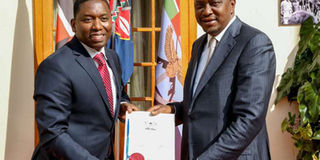New mining law hopes to generate Sh300bn annual revenue by 2030

President Uhuru Kenyatta presents the 2016 Mining Act to Mining Cabinet Secretary Dan Kazungu at State House in Nairobi on June 13, 2016. PHOTO | PSCU
What you need to know:
New mining law creates the Mining Rights Board and a new parastatal, the National Mining Corporation.
New entities will require management boards and secretariats.
Mining Cabinet Secretary Dan Kazungu said Kenya minerals are worth trillions of shillings and the new law will help the country reap handsomely from them.
Lobbying for influential positions has started in earnest in the new legal order that will govern mining.
The new mining law replaced laws enacted in the 1940s just after World War II.
The law creates the crucial Mining Rights Board, which will vet applications for licenses, as well as a new parastatal, the National Mining Corporation.
It also creates the Minerals and Metals Commodities Exchange, a parastatal that will deal with the trading of minerals.
All these bodies will require not only boards but secretariats as well. These are the jobs many are eyeing.
Mining Cabinet Secretary Dan Kazungu said Kenya minerals are worth trillions of shillings and the new law will help the country reap handsomely from them.
The minister said he hopes to have the board by the end of July.
The board will arguably be the most powerful body and hence the rush to have it set up.
It will advise the mining secretary on who to grant mineral rights to or who to bar.
The Nation has learnt that investors in mining are pushing to be on the boards.
YEAR-END TARGET
Members allied to TNA and URP also want in on these boards. The minister admitted that lobbying has been going on.
“Lobbying for jobs is not illegal. It is okay for people to express interest. The bottom line is that we want to hire the best manpower Kenya can offer. We want people who can actualise the vision of this ministry,” he said.
The President is expected to appoint the chairman while the Council of Governors will nominate a representative as three other people with relevant qualifications will also be nominated.
At the National Mining Corporation, the President will appoint the chairman in addition to three representatives from other related ministries.
Mr Kazungu said the ministry is keen to have all three bodies running by end of the year.
Gemstones dealer Senator Johnson Muthama said the sector looks forward to working with those who will be appointed.
“The problem we have in Kenya is not lack of people to appoint. Many are qualified for the jobs, but Kenyans believe in shortcuts and want to make quick money,” he said.
Mr Muthama predicted that the changes anticipated in the Act may not come to reality if those responsible for delivering the vision start engaging in corruption.
AERIAL SURVEY
The ministry expects to hit Sh1.6 billion in mining royalties, up from Sh1.35 billion last year.
The ministry also estimates the reforms will increase annual revenue to Sh300 billion by 2030.
“This is the only sector that has wealth worth trillions of shillings, [and] this Act will allow every Kenyan to participate in this process,” the CS said.
Mr Kazungu said the ministry would carry out an aerial survey to map out mineral areas following a budgetary allocation of Sh3 billion in the 2016-2017 financial year.
He said an estimated Sh9 billion will be required to execute the aerial survey, which will be done in phases considering budgetary limitations.
The first phase of the study will be carried over the coastal, eastern and western blocks, where, among other minerals, titanium, gemstones and gold are prevalent. The old mining Act outlawed small-scale mining.
“It was illegal for small-scale miners to engage in the trade but now that is possible under the new law,” said Mr Kazungu.
The minister said the mining industry, if well managed, has the potential to make a double-digit contribution to the economy unlike now when it is making a paltry 0.8 per cent.





